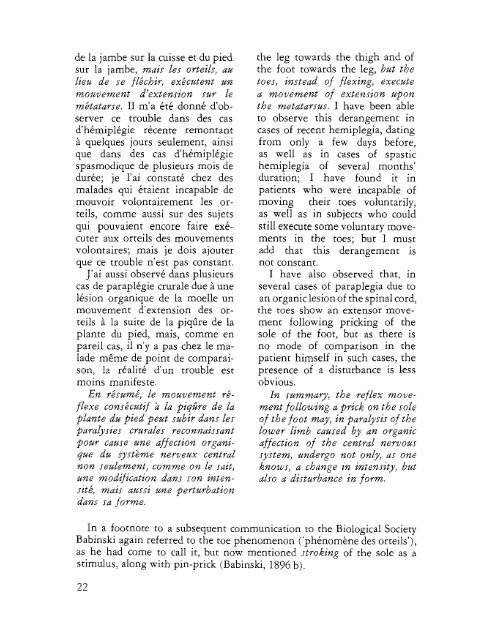You also want an ePaper? Increase the reach of your titles
YUMPU automatically turns print PDFs into web optimized ePapers that Google loves.
de Ia jambe sur Ia cuisse et du pied<br />
sur la jam be, mais les orteils, au<br />
lieu de se flechir, executent un<br />
mouvement d'extension sur le<br />
metatarse. I! m' a ete donne d' observer<br />
ce trouble dans des cas<br />
d'hemiplegie recente remontant<br />
a quelques jours seulement, ainsi<br />
que dans des cas d'hemiplegie<br />
spasmodique de plusieurs mois de<br />
duree; je 1' ai cons tate chez des<br />
malades qui etaient incapable de<br />
mouvoir volonrairement les orteils,<br />
comme aussi sur des sujets<br />
qui pouvaient encore faire executer<br />
aux orteils des mouvements<br />
volontaires; mais je dois ajouter<br />
que ce trouble n'est pas constant.<br />
]' ai aussi observe dans plusieurs<br />
cas de paraplegie crurale due a une<br />
lesion organique de Ia moelle un<br />
mouvement d' extension des orteils<br />
a Ia suite de Ia piqure de Ia<br />
plante du pied, mais, comme en<br />
pareil cas, il n'y a pas chez le rnalade<br />
meme de point de comparaison,<br />
Ia realite d'un trouble est<br />
moins manifesre.<br />
En resume, le mouvement reflexe<br />
consecutif a !a piqure de !a<br />
plante du pied peut subir dans les<br />
paralysies crurales reconnaissant<br />
pour cause une affection organique<br />
du syst'eme nerveux central<br />
non seulement, comme on le sait,<br />
une modification dans son intensitk,<br />
mais aus si une perturbation<br />
dans sa forme.<br />
the leg towards the thigh and of<br />
the foot towards the leg, but the<br />
toes, instead of flexing, execute<br />
a movement of extension upon<br />
the metatarsus. I have been able<br />
to observe this derangement in<br />
cases of recent hemiplegia, dating<br />
from only a few days before,<br />
as well as in cases of spastic<br />
hemiplegia of several months'<br />
duration; I have found it in<br />
patients who were incapable of<br />
moving their toes voluntarily,<br />
as well as in subjects who could<br />
still execute some voluntary movements<br />
in the toes; but I must<br />
add that this derangement rs<br />
not constant.<br />
I have also observed that, in<br />
several cases of paraplegia due to<br />
an organic lesion of the spinal cord,<br />
the toes show an extensor movement<br />
following pricking of the<br />
sole of the foot, but as there is<br />
no mode of comparison in the<br />
patient himself in such cases, the<br />
presence of a disturbance is less<br />
obvious.<br />
In summary, the reflex movement<br />
following a prick on the sole<br />
of the foot may, in paralysis of the<br />
lower limb caused by an organic<br />
affection of the central nervous<br />
system, undergo not only, as one<br />
knows} a change in intensity} but<br />
also a disturbance in form.<br />
In a footnote to a subsequent communication to the Biological Society<br />
Babinski again referred to the toe phenomenon ('phenomene des orteils'),<br />
as he had come to call it, but now mentioned stroking of the sole as a<br />
stimulus, along with pin-prick (Babinski, 1896 b).<br />
22
















